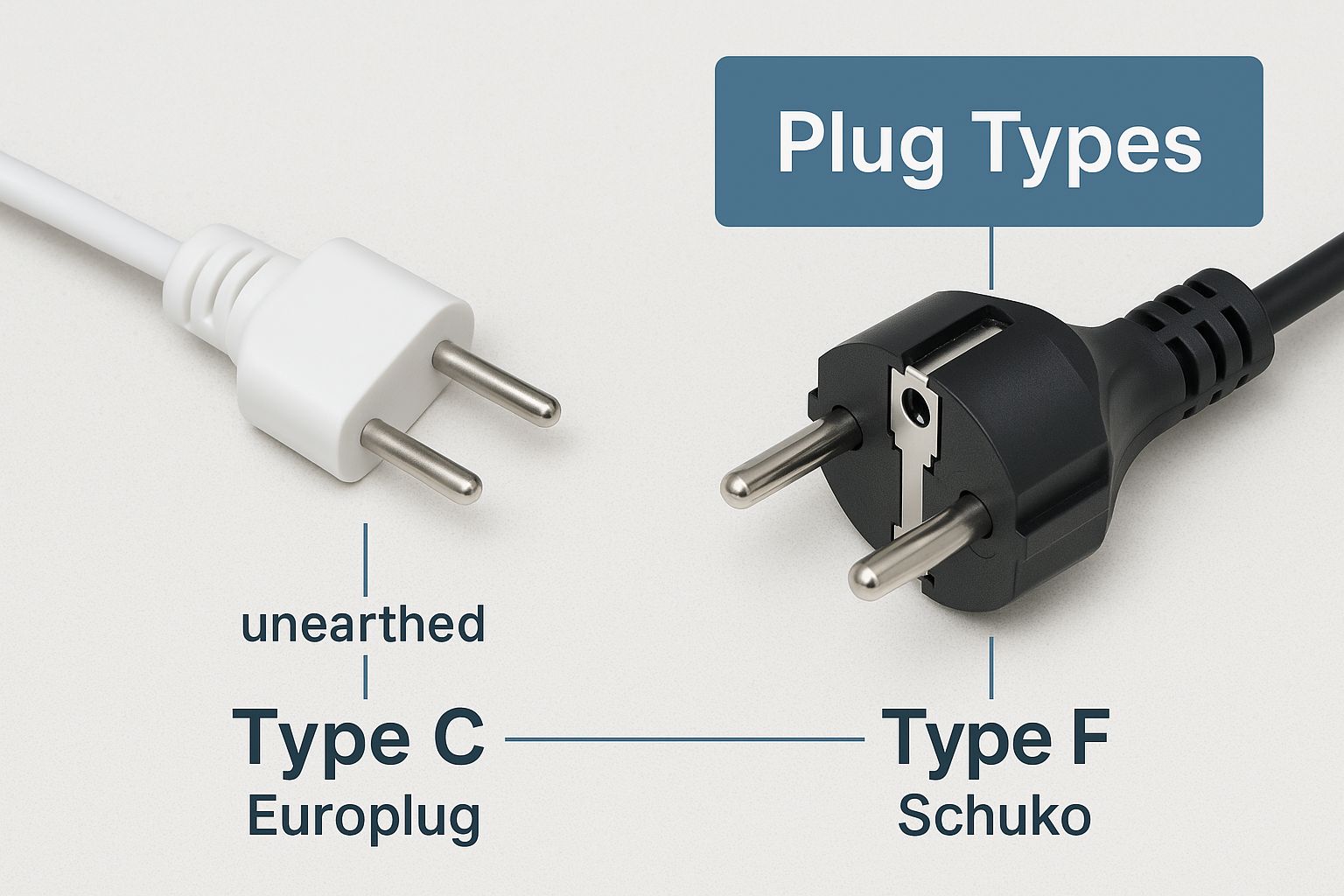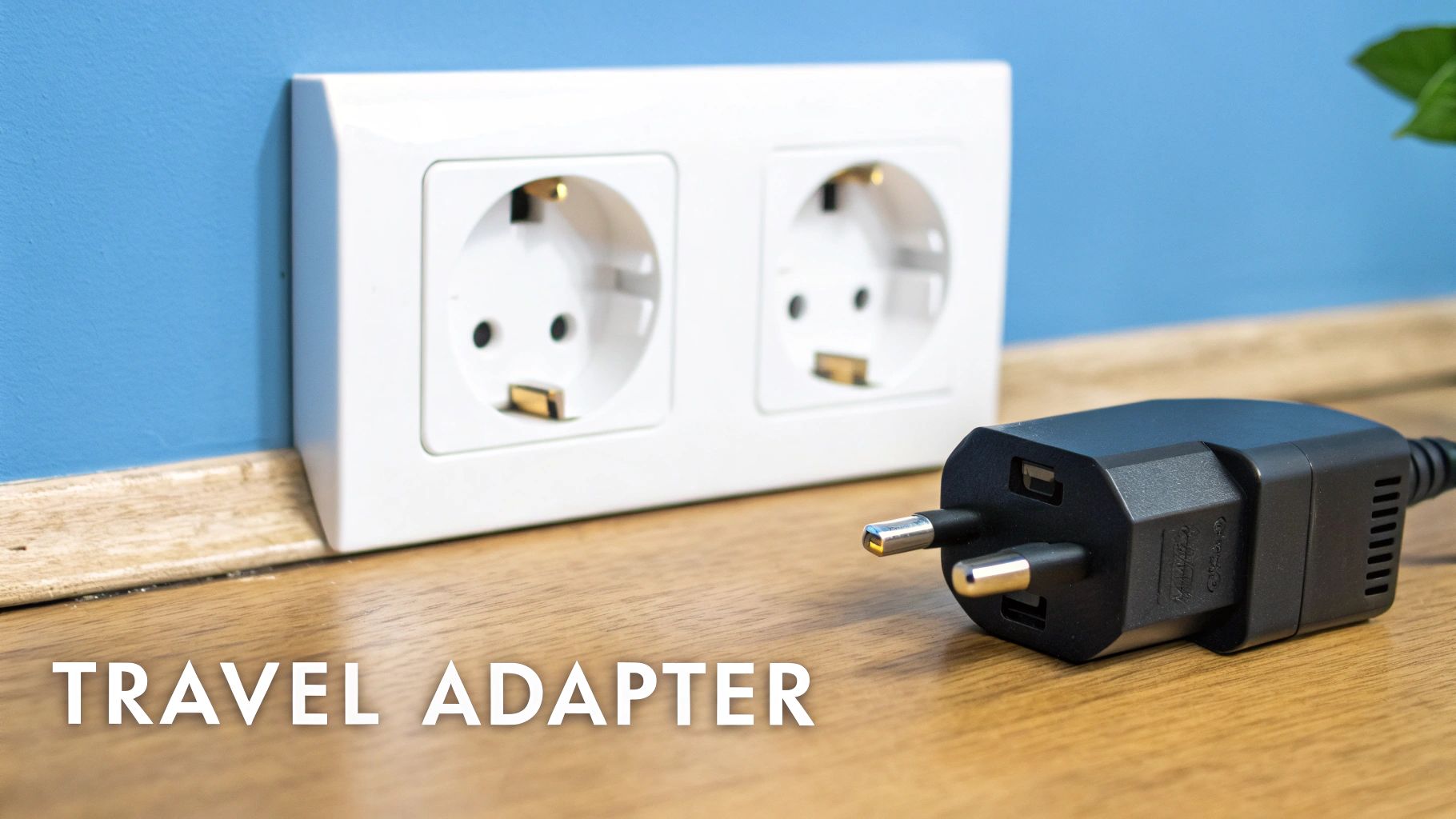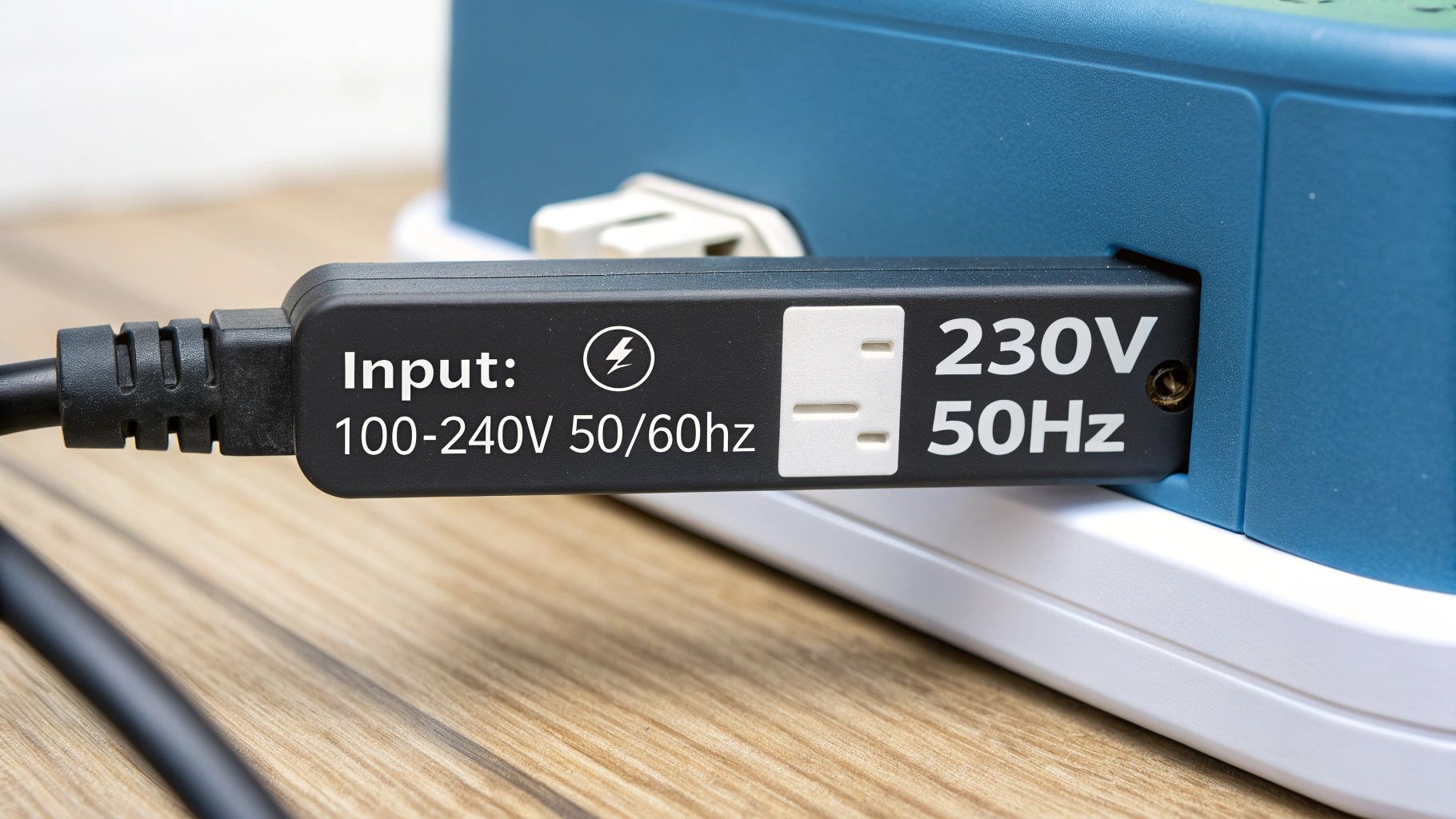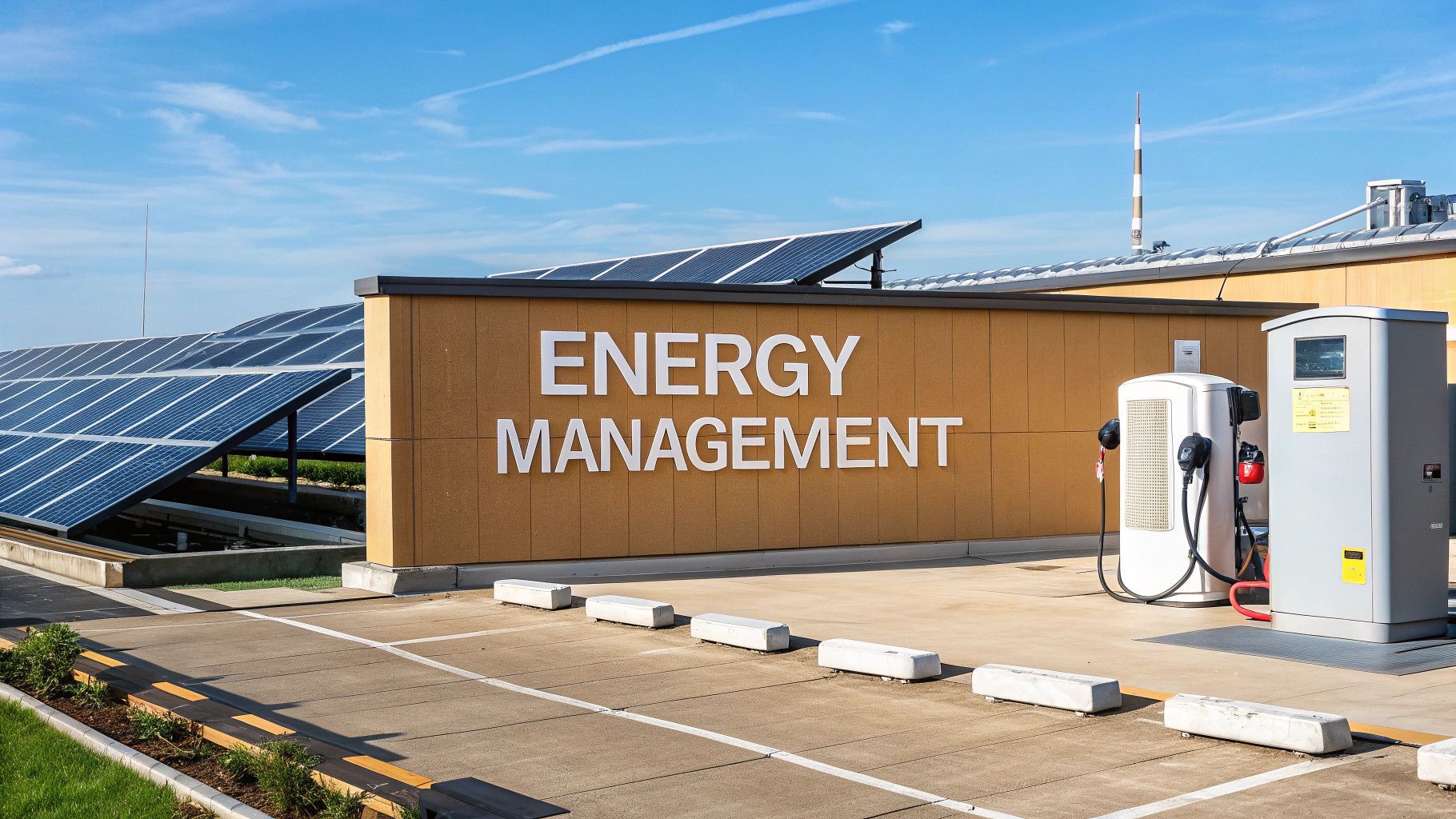What Electrical Plugs Are Used in Greece A Guide
Before you even start dreaming of Greek sunsets and ancient ruins, there’s a small but crucial bit of travel prep to sort out: your electronics. Figuring out what electrical plugs are used in Greece is one of those simple things that can make or break your first day, especially when considering the needs of modern technology from mobile phones to electric vehicles (EVs).
The good news? It’s straightforward. Greece uses Type F sockets , which happily accept both Type C and Type F plugs. For anyone travelling from the UK, this means your standard three-pin Type G plugs simply will not fit. You will definitely need to pack an adapter.
Getting to Grips with Greek Sockets and Plugs
When you’re packing for a Grecian getaway, the last thing you want is to arrive and realise you cannot charge your phone or your mobile EV charger. Luckily, the system in Greece is the same as in most of continental Europe, which makes things much easier.
Greece’s electrical system runs at 230V and a frequency of 50Hz . If that sounds familiar, it’s because it’s almost identical to the UK standard. This is great news for travellers, as it means modern gadgets like phone chargers, laptops and cameras do not need a voltage converter—just a simple plug adapter. It’s one less bulky, expensive bit of kit to worry about. This consistency is also crucial for the burgeoning EV charging infrastructure, allowing for standardised equipment deployment.
A Quick Look at the Plugs
You will mainly come across two types of plugs in Greece: Type C and Type F.
- Type C: Often called the "Europlug", this is a simple two-pin plug. It’s typically used for devices that do not draw much power, like a small travel hairdryer or a phone charger.
- Type F: Known as the "Schuko" plug, this one also has two round pins but adds two grounding clips on the side. This provides an essential earth connection for safety, so you will see it on higher-power appliances like kettles, laptops and mobile EV charging units.
If you want a closer look, this visual guide offers a great explanation of these common European plugs.
To make it even clearer, here’s a quick summary of what you need to know.
Greek Electrical Standards at a Glance
This table breaks down the key electrical information for anyone visiting Greece, especially those coming from the UK.
| Attribute | Specification | Note for UK Travellers |
|---|---|---|
| Plug Types | Type C, Type F | Your Type G plug will not fit. |
| Socket Type | Type F | Compatible with both Type C and F plugs. |
| Voltage | 230V | Nearly identical to the UK ( 230V ). No voltage converter is needed for most devices. |
| Frequency | 50Hz | Identical to the UK ( 50Hz ). |
| Adapter Needed | Yes | You will need a UK-to-EU (Type F) travel adapter. |
So, it all boils down to one simple bit of kit.
The key takeaway is this: your electronics will work just fine with the Greek voltage but your plugs will not fit their sockets. A simple UK-to-EU travel adapter is all you need to stay powered up.
With that sorted, you can focus on the more exciting parts of your trip, safe in the knowledge that whether you are charging an EV or just your camera, you’ve got the right connection.
A Visual Guide to Greek Plug Types
When you are getting ready for a trip to Greece, one of the most practical things to figure out is the power situation. You need to know your phone, laptop and other gear will stay charged without any hiccups.
At first glance, the two plugs you will find— Type C and Type F —look quite similar. But they have key differences, especially when it comes to safety and the amount of power they can handle. It is a small detail but an important one whether you are just charging a phone or plugging in something more demanding like a mobile EV charger.
Type C: The ‘Europlug’
The most common plug across Europe and one you will definitely see in Greece is the Type C . It’s often called the 'Europlug' for good reason. With its two slim, 4.0 mm round pins, it’s a simple, ungrounded design.
This makes it perfect for low-power devices that do not need an earth connection. Think camera battery chargers, electric shavers or anything else that does not draw much current. Its widespread compatibility is a huge plus for anyone travelling through multiple European countries.
Type F: The Grounded ‘Schuko’
For anything that needs a bit more juice, you will be using the Type F plug, also known as a 'Schuko'. This one’s a bit beefier, with two slightly thicker 4.8 mm round pins. More importantly, it features two grounding clips on the sides.
That earth connection is a critical safety feature. It’s essential for higher-wattage appliances like laptops, hairdryers or even mobile EV chargers, protecting both you and your equipment. This plug is fundamental for safely delivering power, especially for rapid EV charging systems where electrical integrity is paramount.
This infographic gives you a clear side-by-side comparison of the two.

The main takeaway here is spotting those grounding clips on the Type F plug. That is the visual cue that it’s built for safely handling more powerful devices.
How The Plugs and Sockets Work Together
Here is where things get clever. The Greek sockets (which are Type F) are designed to work with both plugs. You can pop a slim Type C plug right into a Type F socket without any trouble, making it super versatile for all your small electronics.
But when you insert a Type F plug, those side clips make firm contact inside the socket, creating that all-important protective earth connection.
This dual compatibility is brilliant. It means your low-power gadgets can be plugged in just about anywhere, while your more power-hungry appliances get the grounding they need to operate safely. It is something to keep in mind, especially if you’re travelling with sensitive or powerful electronics.
While Greece keeps things consistent with the rest of Europe, plug standards can vary wildly once you look further afield. For example, the system is completely different if you are looking at electric plugs in Chile for EV charging, which just goes to show how much standards can differ globally.
Getting The Right Adapter For Greece

If you are travelling to Greece from the UK, a travel adapter is one of those non-negotiable items for your suitcase. Your familiar three-pronged Type G plugs just will not fit into Greek sockets. To keep your devices charged, you’ll need a straightforward UK-to-EU adapter.
Picking the right one is simple but it’s worth knowing exactly what you are buying. You are after a plug adapter , not a voltage converter. Think of an adapter as just changing the shape of the plug to match a different socket. A converter, on the other hand, is a much bulkier device that actually changes the electrical voltage.
Since both Greece and the UK run on a 230V system, you almost certainly do not need a clunky and expensive voltage converter. All your modern gadgets—phones, laptops, camera chargers—are designed to handle this voltage without any issues. This consistency is also a boon for mobile EV charging solutions, which can be designed to operate across a stable European grid.
Tips For Picking A Good Adapter
When you’re buying an adapter, quality really does matter. A cheap, poorly made one can be a genuine safety risk and at best, it might not give you a stable connection for charging.
Here are a few practical tips to keep in mind:
- Check for a Snug Fit: A decent adapter should fit securely into the Greek Type F socket. If it wobbles, you could get an intermittent connection, which is not just annoying but can be a hazard.
- Think About a Multi-USB Adapter: Some of the newer adapters come with built-in USB ports. These are incredibly handy for charging multiple devices at once without needing a separate plug for each one.
- Always Pack a Spare: Adapters are small and infuriatingly easy to leave behind in a hotel room. Tucking a spare in your bag is a smart move, just in case.
The key thing to remember is that you are simply adapting the physical shape of your plug. The adapter itself does not alter the electricity flowing through it. That’s why the similar voltage between the UK and Greece makes life so much easier for travellers.
While we are focused on Greece here, it is useful to know the lay of the land if you are exploring the wider region. For instance, understanding what plugs are used in Cyprus can be helpful for a Mediterranean trip. Of course, standards vary massively around the globe; our guide on the electric plug Tanzania uses is a great example of just how different power systems can be.
Making Sense of Voltage and Frequency When You Travel

We’ve all heard horror stories about fried hair straighteners and laptops that spark and die abroad. It’s a common worry but thankfully, it’s one you can put aside when travelling to Greece from the UK.
This anxiety usually comes from a misunderstanding of voltage and frequency. The good news? The Greek electrical system is a near-perfect match for British devices.
Greece runs on 230V at a frequency of 50Hz , which is virtually identical to the UK standard. This simple fact means your modern gadgets, from phone chargers to laptops, are already good to go. You won’t need to lug around a heavy, expensive voltage converter—just a simple plug adapter will do the trick. The stability of this supply is essential for sensitive electronics and forms the backbone of reliable distributed energy networks.
While the plug shapes are different, the power itself is the same. In fact, a 2024 survey of Greek hotels and public spaces found that roughly 85% of wall sockets are the modern Type F (Schuko) variety. This standardisation makes life much easier for travellers and is foundational for deploying technologies like EV charging from constrained grid connections, where stable voltage is key.
How To Check Your Devices Are Ready
There’s a really simple way to confirm your device is travel-ready. Just flip it over and look for the power label, which is usually on the plug, charger or hidden on the back of the appliance itself.
You’re looking for the magic phrase: ‘INPUT: 100-240V 50/60Hz’ . If you see this, your device is "dual-voltage" and will work perfectly in Greece—and many other countries—with nothing more than a plug adapter.
That tiny block of text is your green light to plug in with confidence. Knowing this little trick isn’t just useful for Greece; it is a game-changer for any international travel, as standards can vary wildly. This same principle applies to advanced energy systems; grid-scale batteries and on-site renewables must be designed to integrate seamlessly with local grid specifications to ensure efficiency and safety.
Ever wondered why the plugs in Greece look the way they do? It is not by accident. The familiar Type C and F sockets you will find across the country are the result of a deliberate move towards standardisation, designed to improve safety and bring Greece in line with the rest of Europe.
It was not always this way, though. For years, Greece had its own unique standard known as the ‘Tripoliki’ socket. Named for its three-pin design, this was the go-to for any grounded appliance. But as Europe began to harmonise its electrical standards, Greece started a transition of its own.
By the mid-1980s, the move away from the old Tripoliki system to the Schuko (Type F) socket was largely complete. This was a big deal – it boosted safety and made Greece’s power grid compatible with its neighbours. If you are curious about the bigger picture, Wikipedia has a great rundown on the history of AC power plugs.
From Local Standard to European Integration
This was not just about swapping out plastic sockets; it was a key step in Greece's integration into a common European framework.
Adopting the Schuko system meant that appliances from Germany, Spain and many other countries would work without a hitch. This benefit is even more important today for travellers and our increasing reliance on power for everything from laptops to rapid EV charging.
Because this change happened decades ago, you would be extremely hard-pressed to find an old Tripoliki socket in any hotel, villa or modern home today. So, you can pack your standard European travel adapter with complete confidence, knowing it will fit perfectly wherever you go.
Your Questions About Greek Plugs Answered
To make sure you are fully prepared, let us tackle some of the most common questions travellers have about using their electronics in Greece. Think of this as your final checklist for a smooth, fully-charged trip.
We have designed each answer to give you practical advice for real-world scenarios, so you know exactly what to expect when you get there.
Can I Use My UK Hairdryer in Greece?
Yes, absolutely. You can use your UK hairdryer in Greece with a simple travel adapter, so there is no need to leave it behind.
The great news is that both the UK and Greece run on a 230V system, meaning you will not need a bulky voltage converter. It’s always smart to glance at the label on your hairdryer just to be sure it’s happy with a 50Hz frequency—which nearly all modern ones are. The only thing you will need is a UK Type G to EU Type F adapter to physically plug it in.
Are USB Sockets Common in Greek Hotels?
They’re becoming more common but you definitely should not count on them. While you might find dedicated USB charging sockets in newer or recently refurbished hotels and airports, they are far from standard across Greece.
It’s much safer to assume you’ll be charging your devices the old-fashioned way, via a wall socket. Be sure to pack your standard three-pin UK plug for your USB charger and a good UK-to-EU travel adapter. Relying on finding direct USB ports, especially in smaller hotels or older buildings, is a bit of a gamble.
What Adapter Do I Need for My Laptop in Greece?
For your laptop, all you will need is a standard UK-to-EU travel adapter. This will convert your three-pin Type G plug into a two-pin Type F or Type C plug that fits Greek sockets.
Laptop power supplies are almost always designed for worldwide use, typically accepting a voltage range of 100-240V and 50/60Hz. Because of this, a voltage converter is not necessary.
Since laptops are earthed appliances, it’s best to use a well-made adapter that fits snugly into a Type F (Schuko) socket. This ensures a stable and safe connection for your device, which is particularly important if you are using it to manage energy systems or monitor EV charging cycles.
Can I Buy a Travel Adapter in Greece if I Forget Mine?
Of course. If you do happen to forget your adapter, do not panic. Travel adapters are widely available in Greece, particularly in tourist hotspots, airports and larger supermarkets or electronics shops. You’ll have no trouble finding one in major cities or on popular islands.
That said, they might be a bit more expensive than buying one before you leave home. It is also far more convenient to have one ready in your bag upon arrival so you can start charging your phone and other gadgets straight away. We would always recommend picking one up in the UK before you depart—it’ll save you both time and money.
At ZPN Energy , we specialise in advanced energy solutions that power the future. From rapid EV charging from constrained grid connections to integrating grid-scale batteries with on-site renewables, we are dedicated to building a sustainable and efficient distributed energy infrastructure. Discover our work at https://www.zpnenergy.com.








